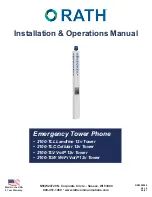
1-8
Cisco Unified Wireless IP Phone 7921G Administration Guide for Cisco Unified Communications Manager Release 7.0
OL-15985-01
Chapter 1 Overview of the Cisco Unified Wireless IP Phone 7921G
Understanding Security Features for Cisco Unified IP Phones
For information about supported security options for the Cisco Unified Wireless IP Phone 7921G, see
the
“Authentication Methods” section on page 2-14
.
Overview of Supported Security Features
Table 1-2
provides an overview of the security features that the Cisco Unified Wireless IP Phone 7921G
supports. For more information about these features and about Cisco Unified Communications Manager
and Cisco Unified IP Phone security, refer to Cisco Unified Communications Manager Security Guide.
For information about current security settings on a phone, choose SETTINGS > System
Configuration > Security Configuration. For more information, see the
“Viewing Security
Information” section on page 8-1
.
Note
Most security features are available only if a certificate trust list (CTL) is installed on the phone. For
more information about the CTL, refer to “Configuring the Cisco CTL Client” chapter in the Cisco
Unified Communications Manager Security Guide.
Troubleshooting
See the
“General Troubleshooting Information”
section on page 10-14
Refer to Cisco Unified Communications Manager
Security Guide, Troubleshooting chapter
Resetting or restoring the phone
See the
“Erasing the Local Configuration” section
on page 10-18
Table 1-1
Cisco Unified IP Phone and Cisco Unified Communications Manager
Security Topics (continued)
Topic
Reference
Table 1-2
Overview of Security Features
Feature
Description
Image authentication
Prevents tampering with the firmware image before it is loaded on
a phone by using signed binary files (with the extension.sbn).
Tampering with the image causes a phone to fail the authentication
process and reject the new image.
Customer-site certificate
installation
Authenticates each Cisco Unified IP Phone by using a unique
certificate. Phones include a manufacturing installed certificate
(MIC), but for additional security, you can specify in Cisco
Unified Communications Manager Administration that a certificate
be installed by using the Certificate Authority Proxy Function
(CAPF). Alternatively, you can install a locally significant
certificate (LSC) from the Security Configuration menu on the
phone. See the
“Configuring the Security Certificate on the Phone”
section on page 5-12
for more information.
















































